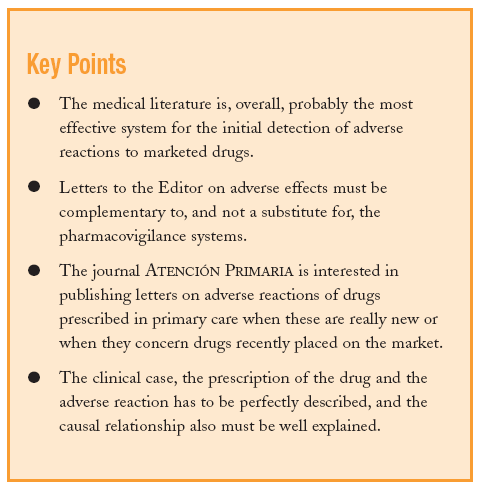The comparative analysis of adverse drug reactions published in the Letters to the Editor section of 4 Spanish internal medicine and general medicine journals by Sempere et al has prompted the editorial committee of the journal Atención Primaria to reconsider its policy on this subject. The study shows that the letters published in different journals have similar characteristics.
The cases are normally well described, since they give sufficient information on the patient, the disease, the medication taken and the adverse reaction. They also enable a causal relationship1 to be established but, overall, their relevance is low. The authors did not pass any of them and only those of the journal Medicina Clínica stood out slightly. As pointed out by the authors, Spanish journals publish reactions which are well known, of low severity and on older drugs.
This is almost certainly due to Spanish clinicians sending letters on the more interesting adverse reactions to higher impact journals.
The slight advantage of the journal Medicina Clínica, although it can be attributed to its higher impact index, is probably also due to the fact it has published its policy on this subject. In 1991, the General Secretary of Medicina Clínica clearly set out the information that had to be included in publications on suspect adverse drug reactions.2
It particularly pointed out that only adverse reactions which had editorial interest would be published.
Up until now, the journal Atención Primaria has followed the policy of publishing practically all the adverse drug reactions which it received as letters to the editor. It probably does not make any sense to continue along this line as the pharmacovigilance programmes, using the yellow card system, are well established.
The publication of isolated cases of known adverse reactions only serves to refresh the memory of the medical practitioner. This type of information is probably better placed in the context of a review article in the sections of journals set aside for Continuing Education than in the Letters to the Editor section.
The editorial committee understands that a journal, whose function is to publish studies on primary care, has to make a more significant contribution towards the safety of drugs prescribed after they are placed on the market.
The experts point out that the biomedical literature is probably, overall, the most effective system for the initial detection, since the case descriptions are detailed, the reviewers have check their quality, there are no commercial incentives and they are open to all interested parties. Evidently, not all cases published are true adverse reactions and there is a risk that they might be false positives, but they do serve as an alert on new reactions, to warn on uncommon events and allow population groups at risk to be identified.3
The journal, Atención Primaria, wants to move forward along this line. The editorial committee is interested in publishing letters of isolated cases of adverse reactions to prescribed drugs in primary care when these are really new or when they concern drugs recently placed on the market. These types of articles can encourage original studies which would have an experimental design and serve to check the hypothesis generated by clinical observations. These articles can appear in the Originals section of the journal Atención Primaria if they pass the review process.
Despite the clinical information which appears in the letters on adverse reactions normally being of sufficient quality, we want to pay special attention in that all the aspects considered essential are included.1,2 They must provide information on the sex, age, clinical characteristics of the patient, the suspected drug and other concomitant medication, with information on dates taken, the doses and administration routes, the indication for its use, the time sequence between the appearance of the event and the administration of the drug, the clinical course, other diseases and relevant environmental factors, such as their corresponding dates, previous experience of the patient with the suspected drug or history of reactions to other analogous drugs, previous publications of the same case, if there were any, and other factors which may be relevant to check other specific reactions (e.g., blood levels, histology and ethnic origin). If available, it would be very interesting to notify how the adverse effect has progressed after stopping the drug and what happened when subjected to re-exposure of the drug.
The journal Atención Primaria is interested in publishing letters on adverse reactions of drugs prescribed in primary care when these are really new or when they concern drugs recently placed on the market, which are well described clinically and where the causal relationship can be established. Notifying the pharmacovigilance systems of the effect by yellow card must be done before sending the article to the publisher.









